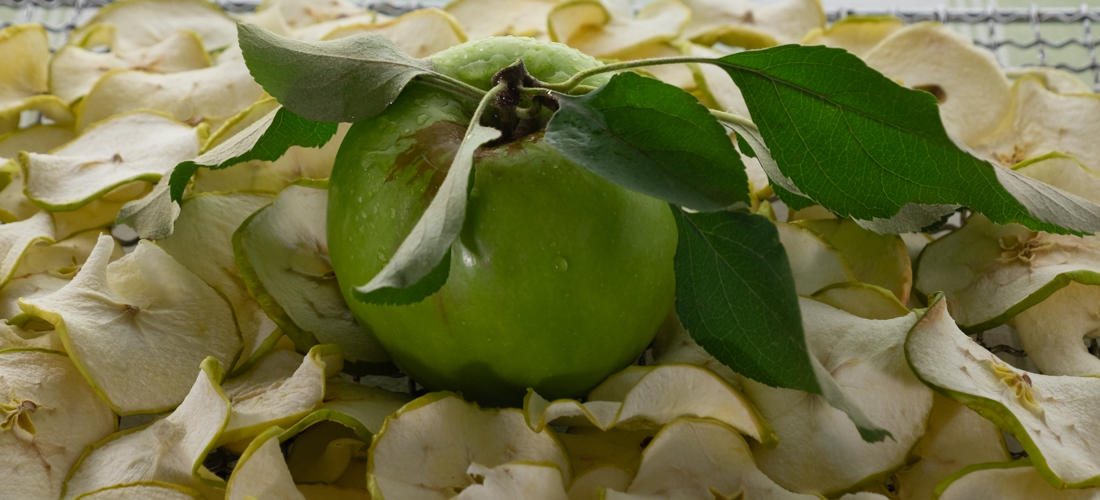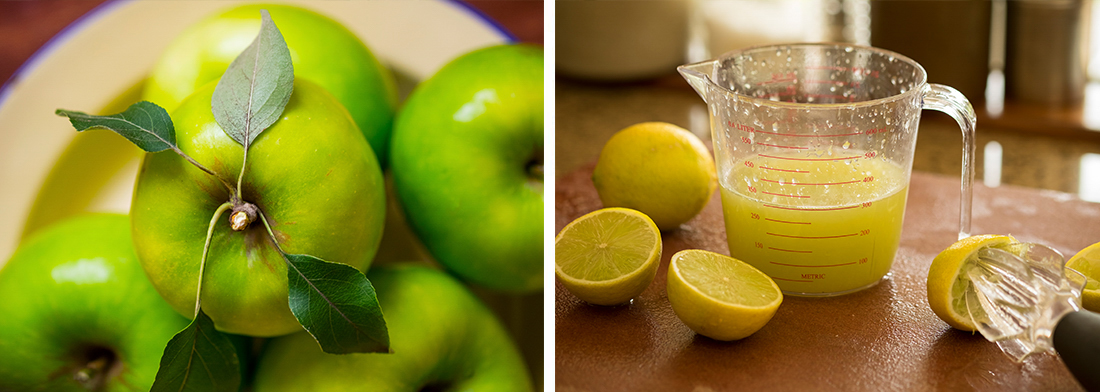Dried Apple
- Drying, Salting & Potting

Dried apples are a simple and effective way to preserve an abundant apple harvest. A highly nutritious light weight snack they are perfect for the lunch box, on the hiking trail or camping trip, added to dried fruit mixtures or reconstituted. A simple 3 step process - wash, cut and dry- it doesn’t get much easier than that. I prefer to use a dehydrator to do all the work as it consistently produces a high-quality product with minimal input from me and isn’t weather dependent. When the autumn harvest season peaks with pears, apples, quinces, and pomegranates and that’s just the fruits, I’m looking for a range of preserving techniques that don’t all demand stove time or constant attention.
Drying is a wonderful technique that releases time to focus on other preserving activities. If you too seek to live a more sustainable lifestyle, take advantage of peak season market buys, and put some sanity and time saving techniques into your kitchen, by considering a dehydrator.
- Preparation Time:
- 30 minutes
- Drying Time:
- 6-8 hours
INGREDIENTS
- 1 kg
- Apples, firm and ripe
- 100 ml
- Lemon juice
- 4 tablespoons
- Ascorbic Acid, powdered (alternative)
- 1.2 litres
- Water

METHOD
To prefect the dried apple, slice fruit evenly using a mandolin if you have one, pre-treat as outlined in the method to prevent the rings from browning, dry the fruit slowly to retain the flavour and don’t over dry.
Place lemon juice and water in a large bowl. Peel, core, and slice apple either into 5 mm (¼ inch) rings or wedge-shaped slices.
Once cut place immediately into the water mixture and ensure each slice is completely submerged for at least 5 minutes.
If using ascorbic acid, dissolve in the 1.2 litres of water, as specified, in the recipe, then continue as outline using the lemon juice and water method.
Lift out and pat each slice dry using kitchen paper or a clean tea towel. Alternatively, place in a salad spinner and spin out the excess lemon juice/water or ascorbic acid/water mixture.
Place the sliced apple, in a single layer, onto the dehydrator tray. Multiple trays may be required depending upon the size and type of dehydrator. Stack additional dehydrator trays on top of each other, place the stack on the dehydrator unit and cover with lid.
Cook at 52-58 degrees C, or at the recommended temperature specified by your dehydrator brand, for approximately 6-8 hours until the apples resemble soft pliable leather.
If drying in the oven, preheat to 49 C (120 F) to 66 C ( 150 F). Place on oven proof racks, turn on the fan and allow to dry slowly.
Drying time will also depend upon the moisture content of the apple, the thickness of the slices.
Allow to cool before storing in labelled paper bags, then within a cardboard box or airtight container. They will go mouldy if they are stored in a plastic bag.
Label and store in a cool, dry and dark place
NOTES
- Apples should be ripe and freshly picked if possible. Do not use over-ripe or floury apples.
- A mandolin is very useful for cutting the fruit the same size. A very handy piece of kitchen equipment.
- Some fruits tend to oxidise more than others when they are cut. Oxidation causes the fruit to brown, relatively quickly, once they have been cut. This is the case with apple. While this may result in a minor loss of flavour and vitamin A and Vitamin C, it does not pose a health risk.
- A pre-treatment is used to prevent the oxidation and apples, peaches, pears ad apricots will be more appetizing, have a longer shelf life and higher nutritional value if treated after slicing and prior to drying.
- Some recipes may recommend sulphating the apples, in a solution of sodium bisulfite.
- According to Fowlers Vaccola, Australia’s iconic home preserving business since 1915, sulphating is not recommended for use for individuals on restricted sodium diets, or who have asthmatic or respiratory conditions.
- During the citrus season, when I have an abundance of lemons and limes, I pre-treat the sliced apples in either a lemon or lime solution. Either of these pre-treatments produces an intense apple flavour with a refreshing hint of citrus. Alternatively dissolve 30ml ascorbic acid in 1.2 litres of boiled cooled water. Ascorbic Acid, Vitamin C is available, in powdered form from pharmacies.
- Drying times can vary and will be influenced by the age, type and efficiency of our dehydrator, fruit moisture content, the thickness and evenness of the sliced fruit and your climatic conditions such as temperature and humidity.
- Fruit should be dried slowly to retain its flavour. Check the slices every hour and turn over as required. Remove any slices that are dried and rearrange the trays as required.
- To test for sufficient drying. They should be pliable and leathery with no pockets of moisture. Tear a piece and no moisture beads should be visible.
- Dried fruit can be eaten raw, included in recipes or reconstituted. To reconstitute cover fruit with boiling water and allow to swell. Add more boiling water if necessary. Leave overnight pour boiling water over the fruit.
- Variations: Dried chillies, lime, blood orange, lemon, mandarin, grapefruit.
What can go wrong.
- Mould and /or unpleasant smell: Dried fruit stored in damp condition.
- Perished fruit: Fruit not dried enough.
- Scorched fruit: Drying heat is too hot and for too long.
- Sweating fruit: Fruit not allowed to cool before packaging and storing
